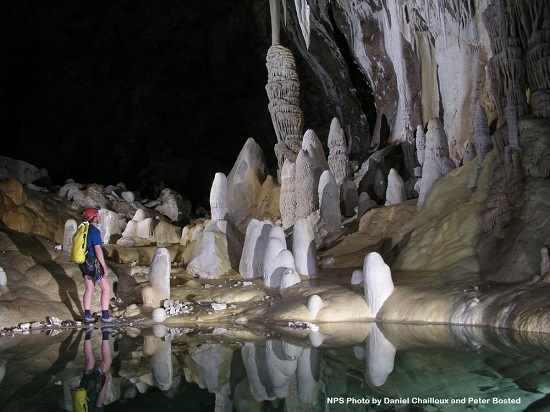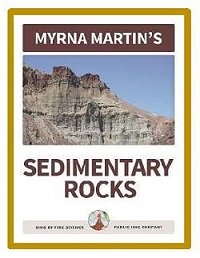Limestone Caverns are holes in rocks
Limestone caves & caverns
Acidic groundwater creates caves
Limestone caverns form when slightly acid groundwater seeping through limestone rocks dissolves a hole in the rock. Over time the hole increases in size forming caves that are sometimes miles long. The groundwater carries the dissolved calcite away in solution and deposits it in other caves as a limestone formation.
Most common type of cave on Earth
Limestone caves are natural cavities in limestone rocks.
They often contain beautiful cave formations known as speleothems. The caves range in size from a few meters to many
kilometers in length. Limestone caves are the most common type of cave on our
planet. Lascaux caves, Carlsbad Caverns, and Lechuguilla Cave are world famous.
Each of the caves are unique. Lascaux cave in France is a World Heritage Site.

Lechuguilla Cave near the Carlsbad Caverns National Park, NPS
formation of limestone on the seafloors
Calcite shells on the seafloor
Most limestone is made of the mineral calcite (calcium carbonate). Marine organisms that create calcite
shells use carbon dioxide and calcium to form their exoskeletons. After they
die their calcite shells collect on the seafloor in sedimentary layers.
Lime mud on the seafloors turn to stone
Deep layers of lime mud form on the seafloor causing the
bottom layers to compress. The weight of the overlying layers compress the material underneath. The weight of the overlying layers cause the sediment particles closer together and compacting them. The compressed layers turn to stone (lithify)
becoming limestone reefs and other limestone formations.
Formation of limestone caves
Acidic water dissolves limestone
Rainwater picks up carbon dioxide in the air. The rainwater and carbon dioxide form a weak solution of carbolic acid. Limestone is a porous rock that dissolves when groundwater contains carbolic acid. Cracks and crevices enlarge as the limestone dissolves creating caves and caverns. Limestone caves are the most common type of cave on our planet.
Excess limestone in groundwater
The limestone that dissolves is carried away by groundwater to other areas where it is deposited in caves as stalactites, stalagmites, flowstone and other speleothems.
Speleothems formation in caves
Speleothems are mineral deposits
Speleothems are mineral deposits formed in caves by flowing, dripping or seeping water. Most speleothems are formed by calcite, aragonite and gypsum. The shape of speleothems is determined by the flow behavior of the water. Examples of speleothems is stalactites, stalagmites, and flowstone.
Stalactite formation
Water dripping into the cave evaporates and calcite dissolved in the water precipitates out to form travertine. Stalactites are icicle-like formations that hang from the ceiling in limestone caves.
Stalagmite formation
Below the growing stalactite is a stalagmite. Stalagmites grow from the ground up as the travertine crystallizes on the ground. Flowstone forms when the groundwater flows down the surface of a cavern wall.


Click for More Information and to Order
Carlsbad caverns
Jim White explored and named many of the famous rooms
Jim White, a teenager in 1898, explored the
cavern using a homemade wire ladder. He named some of the most famous rooms and
formations in the caves. The groundwater flowing through the porous limestone
created the Carlsbad Caverns and Lechuguilla Cave. Tectonic plate movement uplifted
the area forming the Guadalupe Mountains where the caves are located.
Area once the coastline of an inland sea
The area surrounding the national park was the coastline
of an inland sea. A Permian reef formed containing fossils of bryozoans,
sponges, and other microorganism living in the area. The ocean dried up and the
reef was covered with layers of evaporite minerals and other sediments.
Erosions and weathering of the limestone shaped the mountains into their
present form today.
Visiting Carlsbad Caverns
The Carlsbad Caverns
National Park is open to the public year around. The temperature inside the
caves is 13°
C. In 2016 there were over 466,000 visitors to the caverns. The caverns are lit
but visitors can bring a flashlight when they visit the caves.
Lechuguilla Cave
Discovery of Lechuguilla cave
Cavers decided to investigate a deep pit near named Misery Hole near Carlsbad Caverns. They dug around at the bottom of the pit and discovered the entrance to the cave.
Lechuguilla Cave
The March 1991 issue of National Geographic Magazine includes spectacular pictures of Lechuguilla Cave. The cave is located within five miles of the Carlsbad Caverns in New Mexico.
Speleothems in Lechuguilla Cave
Lechuguilla Cave has many fascinating and unusual
speleothems in the cave. The caves contain lemon-yellow sulfur deposits six meters high. Gypsum
chandeliers are six meters tall. These deposits led scientists to discover the
fact that indicate the cave formed from the bottom up. The caves formed when
water containing sulfuric acid flowing through the limestone created the cave.
History and discovery
The cave was known for a long time and considered an
insignificant cave. The entrance pit to the cave was 27 meter deep. It was
known as “the misery hole”. A miner in 1914 had a permit and mined bat guano in
the only chamber known at the time.
Fifth longest cave in the world
Lechuguilla Cave is now ranked as the 5th
longest cave in the world and the 3rd longest in the United States.
The cave’s pristine condition and rare beauty brought cavers from all over the
world to explore the passages and study the geology of the cave.
Cavers climbed 120 meters into a dome in 2012 and discovering new passages, pits, and large rooms. The known total length of the cave is 226.6 km long and 489 m deep. The cave contains five separate geologic formations that are now being studied inside the cave.
Lascaux cave in France
Discovering Lascaux caves
The Lascaux caves are Paleolithic caves located in
southwestern France near the village of Montignac. The caves were discovered by
four boys on September 12, 1940 when they were examining a fox hole.
The boys constructed a makeshift lamp to light their way
and discovered a wide variety of animal paintings on the walls. The next day
they again visited the cave with better lighting. They told their teacher about
what they had found. Plans were set in motion to excavate the cave. By 1948 the
cave was open to the public.
Prehistoric cave paintings
The caves house some of the most famous examples of
prehistoric cave painting ever discovered. There are close to 600 paintings on
the interior cave walls and ceilings in the caves. There are also 1400
engraving in the cave. Many other caves in the region also have beautiful
paintings on their walls.
The cave paintings were painted about 20,000 years ago. They include horses, deer, aurochs, ibex, and bison. The paintings were completed by many generations of skilled artisans living in the area at the time.
KIDS FUN Science Bookstore
Check out Myrna Martin's award winning textbooks, e-books, videos and rock sets. The Kids Fun Science Bookstore covers a wide range of earth science topics. Click here to browse.










